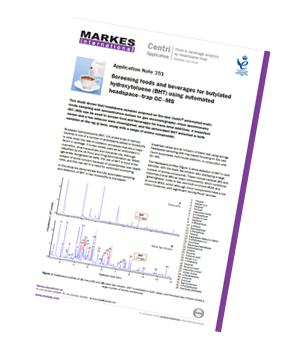Markes International has produced an application note demonstrating the fully automated sampling and detection of Butylated Hydroxytoluene (BHT) in two foodstuffs using automated headspace–trap GC–MS.

Abstract
This study shows that headspace samples acquired on the new Centri® automated multimode sampling and concentration system for gas chromatography–mass spectrometry (GC–MS) can be used to screen food and beverages for trace-level additives. A breakfast cereal and a tea infusion were investigated, and the antioxidant BHT detected in both samples at the ng/g level, along with a range of aroma compounds.
Introduction
Butylated hydroxytoluene (BHT, 3,5-di-tert-butyl-4-hydroxytoluene) is one of a number of antioxidants added to foodstuffs to slow down the rate of oxidation processes that are a major factor in spoilage. It is also widely used as an antioxidant in cosmetics, pharmaceuticals and industrial oils. Although classified by the US Food and Drug Administration as ‘GRAS’ (generally recognised as safe), the use of BHT in food is the subject of some concern because of uncertainties over health risks, and this has led to a need for continued monitoring. In this study we demonstrate the fully automated sampling and detection of BHT in two foodstuffs (a rice-based breakfast cereal and an infusion of black tea) using syringe headspace sampling with trap-based focusing on the new Centri automated multi-mode platform, in conjunction with GC–MS.
Results and Discussion
Quantitation for BHT was achieved on the basis of a six-point calibration curve from 1–50 ng, and indicated concentrations of 0.73 ng/g for the rice puffs, and 1.6 ng/g for the black tea infusion.
Two features of this analysis combine to allow sub-nanogram sensitivity for headspace sampling:
- The use of analyte re-focusing on the Centri focusing trap results in better GC–MS peak shape compared to headspace methods that do not use analyte focusing.
- The use of a very low 2:1 split ratio for the injection means that a large proportion of the sample is sent to the GC–MS.
On many trap-based systems, the use of such a low ratio would result in poor peak shape, but this is avoided with Centri because of the optimised design and highly efficient backflush desorption of the focusing trap.
Conclusion
The ability of Centri to offer highly sensitive headspace–trap analysis of foods and beverages for improved detection of trace-level additives and aroma compounds is demonstrated. This capability is complemented by the other sampling modes available with Centri – HiSorb high-capacity sorptive extraction, thermal desorption and SPME – all of which can benefit from cryogen-free trapping for enhanced sensitivity. In addition, by allowing unattended sequential analysis of multiple sample types using different injection modes, Centri greatly improves efficiency for high-throughput laboratories.




